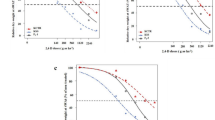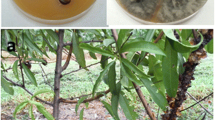Abstract
The mode of inheritance of resistance to bipyridyl herbicides in bipyridyl-resistant biotypes of Arctotheca calendula and of Hordeum leporinum was investigated. F1 plants from reciprocal crosses between diquat-resistant and -susceptible plants of A. calendula showed an intermediate response to diquat application that was nuclearly inherited. Treatment of F2 plants with 100 g ai ha-1 of diquat or 800 g ai ha-1 of paraquat killed all homozygous-susceptible plants, caused severe injury to heterozygous plants but only slight or no injury to homozygous-resistant plants. Back crosses of F1 to susceptible plants exhibited intermediate and susceptible phenotypes. The observed segregation ratios in F2 and test-cross populations fitted predicted segregation ratios, 1:2:1 (R:I:S) and 1:1 (I:S) respectively, showing that bipyridyl resistance is conferred by a single incompletely-dominant gene. Biotypes of paraquat-resistant and -susceptible H. leporinum were crossed reciprocally. F1 plants from reciprocal crosses showed an intermediate response to paraquat application. The F2 progeny showed segregation ratios that fitted the predicted segregation ratio of 1:2:1 (R:I:S) forinheritance of resistance being governed by a single partially-dominant gene.
Similar content being viewed by others
References
Andersen RN, Gronwald JW (1987) Noncytoplasmic inheritance of atrazine tolerance in velvetleaf (Abutilon theoprasti). Weed Sci 35:496–498
Betts KJ, Ehlke NJ, Wyse DL, Gronwald JW, Somers DA (1992) Mechanism of inheritance of diclofop resistance in Italian ryegrass (Lolium multiflorum). Weed Sci 40:184–189
Bishop T, Powles SB, Cornic G (1987) Mechanism of paraquat resistance in Hordeum glaucum. II. Paraquat uptake and translocation. Aust J Plant Physiol 14:539–547
Darmency H, Pernes J (1985) Use of wild Setaria viridis (L.) Beauv. to improve triazine resistance in cultivated S. italica (L.) by hybridization. Weed Res 25:174–179
Faulkner JS (1974) Heritability of paraquat tolerance in Lolium perenne L. Euphytica 23:281–288
Goodenough U (1978) Genetics. Holt-Saunders Int. Editions, New York
Harper DB, Harvey BMR (1978) Mechanism of paraquat tolerance in perennial ryegrass. II. Role of superoxide dismutase, catalase and peroxidase. Plant Cell Environ 1:211–215
Islam AKMR, Powles SB (1988) Inheritance of resistance to paraquat in barley grass Hordeum glaucum Steud. Weed Res 28:393–397
Itoh K (1988) Paraquat resistance in Erigeron philadelphicus L. Jap Agric Res Q 22:85–90
Itoh K, Miyahara M (1982) Inheritance of paraquat resistance in Erigeron philadelphicus L. Weed Res (Japan) 29:301–307
Mallory-Smity CA, Thill DC, Dial MJ, Zemetra RS (1990) Inheritance of sulfonylurea herbicide resistance in Lactuca spp. Weed Tech 4:787–790
Pfister K, Steinback KE, Gardner G, Arntzen CJ (1981) Photoaffinity labelling of a herbicide receptor protein in chloroplast membranes. Proc Natl Acad Sci USA 78:981–985
Powles SB (1986) Appearance of a biotype of the weed, Hordeum glaucum Steud., resistant to the herbicide paraquat. Weed Res 26:167–172
Powles SB, Howat PD (1990) A review of weeds in Australia resistant to herbicides. Weed Tech 4:178–185
Powles SB, Tucker ES, Morgan TR (1989) A capeweed (Arctotheca calendula) biotype in Australia resistant to bipyridyl herbicides. Weed Sci 37:60–62
Preston C, Holtum JAM, Powles SB (1992) On the mechanism of resistance to paraquat in Hordeum glaucum and H. leporinum. Delayed inhibition of photosynthetic O2 evolution following paraquat application. Plant Physiol 100:630–636
Scott KR, Putwain PD (1981) Maternal inheritance of simazine resistance in a population of Senecio vulgaris. Weed Res 21:137–140
Shaaltiel Y, Chua NH, Gepstein S, Gressel J (1988) Dominant pleiotropy controls enzymes co-segregating with paraquat resistance in Conyza bonariensis. Theor Appl Genet 75:850–56
Souza Machado V, Bandeen JD, Stephenson GR, Lavigne P (1978) Uniparental inheritance of chloroplast atrazine tolerance in Brassica campestris. Can J Plant Sci 58:977–981
Tucker ES, Powles SB (1991) A biotype of hare barley, Hordeum leporinum, in Australia resistant to paraquat and diquat. Weed Sci 39:159–162
Yamasue Y, Kamiyama K, Hanioka Y, Kusanagi T (1992) Paraquat resistance and its inheritance in seed germination of the foliar-resistant biotypes of Erigeron canadensis L. and E. sumatrensis Retz. Pest Biochem Physiol 44:21–27
Author information
Authors and Affiliations
Additional information
Communicated by J. W. Snape
Rights and permissions
About this article
Cite this article
Purba, E., Preston, C. & Powles, S.B. Inheritance of bipyridyl herbicide resistance in Arctotheca calendula and Hordeum leporinum . Theoret. Appl. Genetics 87, 598–602 (1993). https://doi.org/10.1007/BF00221884
Received:
Accepted:
Issue Date:
DOI: https://doi.org/10.1007/BF00221884




